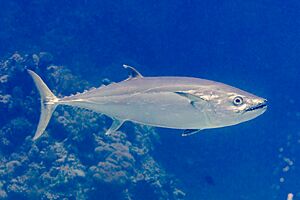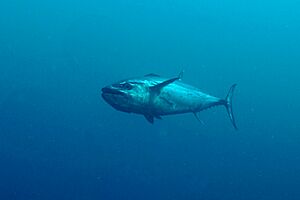Dogtooth tuna facts for kids
Quick facts for kids Dogtooth tuna |
|
|---|---|
 |
|
| Gymnosarda unicolor from French Polynesia | |
| Conservation status | |
| Scientific classification | |
| Synonyms | |
|
List
Gymnosarda nuda (Günther, 1860)
Pelamys nud a Günther, 1860 Scomber vau Curtiss, 1938 Thynnus unicolor Rüppell, 1836 |
The dogtooth tuna (Gymnosarda unicolor), also known as white tuna, is a large, fast-swimming marine fish that lives in the ocean. It belongs to the Scombridae family, which includes other tunas and mackerels. These powerful fish are known for their sharp, dog-like teeth, which help them catch their prey.
Contents
Discovering the Dogtooth Tuna
What Does a Dogtooth Tuna Look Like?
Dogtooth tuna are quite big! Males can grow up to 248 centimetres (98 in) (about 8 feet) long and weigh up to 130 kilograms (290 lb) (around 287 pounds). Most often, they are seen between 40 centimetres (16 in) and 120 centimetres (47 in) long.
They have a sleek, torpedo-shaped body, perfect for swimming fast. Their back is a shiny blue-green, their sides are silvery, and their belly is whitish. They also have two white tips on their back fins. A special wavy line, called a lateral line, runs along their body. Dogtooth tuna always swim with their mouths open, and their large upper jaw reaches their eye.
Where Do Dogtooth Tuna Live?
Dogtooth tuna live in the warm, tropical waters of the Indo-Pacific region. This huge area stretches from the eastern coast of Africa, including the Red Sea, all the way to French Polynesia and other islands in the Pacific Ocean. You can find them as far north as Japan and as far south as Australia. They do not live near Hawaii.

Dogtooth Tuna in Their Ocean Home
What is Their Habitat?
These ocean fish mostly live around coral reefs. Younger, smaller dogtooth tuna prefer shallow reef areas. Larger ones like deeper spots, such as steep underwater walls and seamounts (underwater mountains). They usually swim alone or in small groups. You can find them at depths from 10 metres (33 ft) to 300 metres (980 ft) (about 33 to 984 feet).
What Do Dogtooth Tuna Eat?
Dogtooth tuna are top predators in their environment. This means they are at the top of the food chain, sharing that spot with other big fish like giant trevally and large groupers, as well as sharks.
They are aggressive hunters and eat small schooling fish and squids. Their diet often includes fish found near coral reefs, such as fusiliers, wrasses, and different types of mackerel.
How Long Do They Live?
Scientists believe that dogtooth tuna can live for at least 20 years.
Fishing for Dogtooth Tuna
Why Are They Fished?
Dogtooth tuna are popular for two main reasons: they are considered a delicious food fish and they are a challenging game fish for anglers (people who fish with a rod and reel) and spearfishermen. You can often find them sold canned or frozen.
How Are They Caught?
Catching a large dogtooth tuna is very difficult! When hooked, they often make fast dives towards the bottom. This can cause the fishing line to break if it rubs against rocks or reefs. Sharks also sometimes attack hooked or speared fish, making it even harder to land them.
Fishermen often catch them by trolling, which means dragging bait or lures behind a moving boat. Deep-diving lures are especially popular. Some anglers use live bait, like rainbow runners, to attract the tuna closer.
In recent years, a method called high-speed jigging has become very popular. This involves quickly moving metal lures up and down in the water. New fishing gear, like lightweight rods and reels with strong braided lines, makes this possible.
Popular Fishing Spots
Many sports anglers travel to specific places to try and catch dogtooth tuna. Some popular destinations include Okinawa and other southern Japanese islands, Rodrigues and the Maldives in the Indian Ocean, Bali in Indonesia, the Great Barrier Reef in Australia, and many Western Pacific islands like Vanuatu, Fiji, Tonga, Samoa, and Palau.


